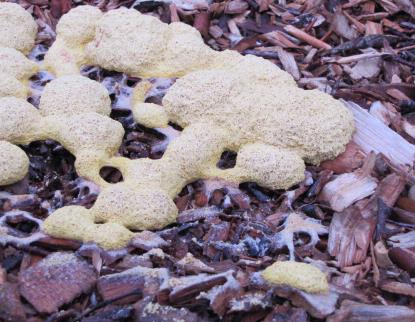Young Juliet foolishly threw her lot in with a Montague, Romeo, saying “What’s in a name? That which we call a rose / By any other name would smell as sweet.” She dismissed his last name because Romeo was a hunk. She’d barely had a conversation with him at this point, so what else could she have been going for? She suggests as much in the preceding lines by cataloging his parts: “What’s Montague? it is nor hand, nor foot,/Nor arm, nor face, nor any other part/ Belonging to a man.”
According to wiki-answers “pATalapuShp” means “rose” in Sanskrit. I wouldn’t want to pronounce that, but I’d be glad to smell it. I imagine Iranian roses smell just as sweet as English ones, or for that matter Veronese. Given this name-as-poor-reflection-of-reality thing (a tip of the hat to Plato), I probably shouldn’t hold the name dog-vomit-slime-mold against the creature pictured here. It doesn’t smell sweet, but by any other name it still wouldn’t be dog-vomit. Nor would it be mold, as mold is a fungus. Instead it would be a plasmodial amoeba that eats bacteria, fungal spores and other organic matter. I may have the species wrong, but I believe this is Fuligo septica. I suppose it sounds speciesist, but yellow slime molds all look alike to me.

When I spotted this particular specimen on our mulch I was doing my usual bio-dork thing: looking really closely and trying to note any distinctive features. The boss opened a window, looked down on me (I’m used to it) and told me in no uncertain terms: “that’s disgusting.” She waited two beats then the inner scientist that has been quashed by Western Medicine poked her head up: “what is it.” I perked right up, “why it’s a dog vomit slime mold.” She slammed the window without another word. Ah well, you can lead a horse to water but you can’t make her appreciate weird organisms.
F. septica, like all plasmodial slime molds (PSMs) is one enormous cell with lots of nuclei. In most organisms there’s one nucleus per cell. In PSMs this multi-nucleate enormous cell slowly undulates its way around the landscape looking for food. These undulations stick to a regular two minute beat (for video: http://www.youtube.com/watch?v=p3goJl_grFU). The organism uses this movement to search for food. Scientists in Japan showed that a different, though quite similar, slime mold can solve mazes, and most oddly recreate a map of the Tokyo rail network when cornflakes were placed to represent major population centers (http://www.youtube.com/watch?v=BZUQQmcR5-g).
So why the name? It’s not really slimy in the way algae is, but it does look kind of slimy. “Mold” refers to fungus and this is no fungus. The cell structure isn’t like a fungus (too many nuclei for one) and it doesn’t have cell walls. Furthermore it doesn’t make spores similar to fungi and it doesn’t form hyphae. But people were happy to call it a fungus for years. The name matters only because we like to classify: ordering things helps us to understand them. But really outside of evolutionary relationships, some of these distinctions are only human. A lichen is a fungus and an algae or cyanobacteria, so where do we classify it? It really doesn’t matter where we put it, it’s just there doing its thing. So sit back and enjoy it, whatever it’s called.


